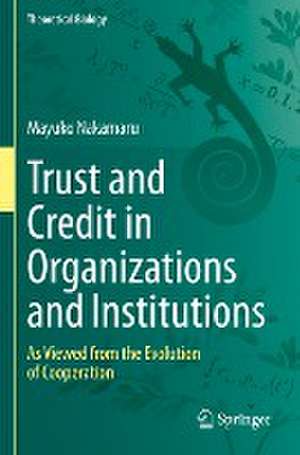Trust and Credit in Organizations and Institutions: As Viewed from the Evolution of Cooperation: Theoretical Biology
Autor Mayuko Nakamaruen Limba Engleză Paperback – 7 ian 2024
This book shows that evolutionary game theory can unravel how mutual cooperation, trust, and credit in a group emerge in organizations and institutions. Some organizations and institutions, such as insurance unions, credit unions, and banks, originated from very simple mutual-aid groups. Members in these early-stage mutual-aid groups help each other, making rules to promote cooperation, and suppressing free riders. Then, they come to “trust” not only each other but also the group they belong to, itself.
The division of labor occurs when the society comes to have diversity and complexity in a larger group, and the division of labor also requires mutual cooperation and trust among different social roles. In a larger group, people cannot directly interact with each other, and the reputation of unknown people helps other decide who is a trustworthy person. However, if gossip spreads untruths about a reputation, trust and cooperation are destroyed.Therefore, how to suppress untrue gossip is also important for trust and cooperation in a larger group. If trustworthiness and credibility can be established, these groups are successfully sustainable. Some develop and evolve and then mature into larger organizations and institutions. Finally, these organizations and institutions become what they are now. Therefore, not only cooperation but also trust and credit are keys to understanding these organizations and institutions.
The evolution of cooperation, a topic of research in evolutionary ecology and evolutionary game theory, can be applied to understanding how to make institutions and organizations sustainable, trustworthy, and credible. It provides us with the idea that evolutionary game theory is a good mathematical tool to analyze trust and credit. This kind of research can be applied to current hot topics such as microfinance and the sustainable use of ecosystems.
| Toate formatele și edițiile | Preț | Express |
|---|---|---|
| Paperback (1) | 729.06 lei 6-8 săpt. | |
| Springer Nature Singapore – 7 ian 2024 | 729.06 lei 6-8 săpt. | |
| Hardback (1) | 735.21 lei 6-8 săpt. | |
| Springer Nature Singapore – 6 ian 2023 | 735.21 lei 6-8 săpt. |
Preț: 729.06 lei
Preț vechi: 889.09 lei
-18% Nou
Puncte Express: 1094
Preț estimativ în valută:
139.54€ • 145.13$ • 116.94£
139.54€ • 145.13$ • 116.94£
Carte tipărită la comandă
Livrare economică 14-28 martie
Preluare comenzi: 021 569.72.76
Specificații
ISBN-13: 9789811949814
ISBN-10: 9811949816
Pagini: 318
Ilustrații: XXII, 318 p. 1 illus.
Dimensiuni: 155 x 235 mm
Greutate: 0.49 kg
Ediția:1st ed. 2022
Editura: Springer Nature Singapore
Colecția Springer
Seria Theoretical Biology
Locul publicării:Singapore, Singapore
ISBN-10: 9811949816
Pagini: 318
Ilustrații: XXII, 318 p. 1 illus.
Dimensiuni: 155 x 235 mm
Greutate: 0.49 kg
Ediția:1st ed. 2022
Editura: Springer Nature Singapore
Colecția Springer
Seria Theoretical Biology
Locul publicării:Singapore, Singapore
Cuprins
What is "the evolution of cooperation"?.- The evolution of cooperation in a lattice-structured population under two different updating rules.- The effect of peer punishment on the evolution of cooperation.- Rotation savings and credit associations (ROSCAs) as an early-stage credit system.- Tanomoshi-ko field study and subjective experiment.- Who does a group admit into membership or which group does a player want to join?.- The mutual-aid game as an early-stage insurance system.- Cooperation and punishment in the linear division of labor.- Can cooperation evolve when false gossip spreads?.- Field abandonment problem in rice paddy fields.- Ecological features benefiting sustainable harvesters in socio-ecological systems: A case study of swiftlets in Malaysia.
Notă biografică
Mayuko Nakamaru
Tokyo Institute of Technology, Tokyo Japan
Tokyo Institute of Technology, Tokyo Japan
Textul de pe ultima copertă
This book shows that evolutionary game theory can unravel how mutual cooperation, trust, and credit in a group emerge in organizations and institutions. Some organizations and institutions, such as insurance unions, credit unions, and banks, originated from very simple mutual-aid groups. Members in these early-stage mutual-aid groups help each other, making rules to promote cooperation, and suppressing free riders. Then, they come to “trust” not only each other but also the group they belong to, itself.
The division of labor occurs when the society comes to have diversity and complexity in a larger group, and the division of labor also requires mutual cooperation and trust among different social roles. In a larger group, people cannot directly interact with each other, and the reputation of unknown people helps other decide who is a trustworthy person. However, if gossip spreads untruths about a reputation, trust and cooperation are destroyed. Therefore, how to suppress untrue gossip is also important for trust and cooperation in a larger group. If trustworthiness and credibility can be established, these groups are successfully sustainable. Some develop and evolve and then mature into larger organizations and institutions. Finally, these organizations and institutions become what they are now. Therefore, not only cooperation but also trust and credit are keys to understanding these organizations and institutions.
The evolution of cooperation, a topic of research in evolutionary ecology and evolutionary game theory, can be applied to understanding how to make institutions and organizations sustainable, trustworthy, and credible. It provides us with the idea that evolutionary game theory is a good mathematical tool to analyze trust and credit. This kind of research can be applied to current hot topics such as microfinance and the sustainable use of ecosystems.
Caracteristici
Applies evolutionary game theory to study organizations and institutions, based on the evolution of cooperation Does field surveys and experiments with mutual-aid systems, which is where some organizations and institutions originate Takes sustainable use of ecological systems as an example of evolved institutions’ application of theory








